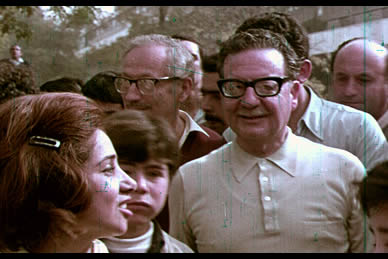Fruto de un hallazgo y trabajo invaluables, por parte de profesionales del plantel, son los documentales “Compromiso con Chile” y “Visita presidencial”, los que serán presentados este miércoles 1 de febrero y que entre otros episodios históricos, registran las visitas de Fidel Castro, Salvador Allende y de Augusto Pinochet a la ex Universidad Técnica del Estado.
La visita de figuras como el presidente Salvador Allende y el general Augusto Pinochet, así como el paso de Fidel Castro por Chile, pero sobre todo el gran protagonismo y aporte que a nivel nacional tuvo la ex Universidad Técnica del Estado (UTE), es sólo parte de lo que recogen los documentales “Compromiso con Chile” y “Visita presidencial”, que serán presentados este miércoles en nuestro plantel, a las 19 horas, en la sala de cine del Centro de Eventos Nacionales e Internacionales (CENI).
Se trata de material audiovisual de altísimo valor histórico, cuyo hallazgo fue hecho en dependencias de la Biblioteca Central de nuestra casa universitaria, y que gracias al trabajo de profesionales expertos en materia de recuperación y conservación audiovisuales, estará a disposición de todo el país, próximamente.
Histórico aporte al desarrollo país
Caracterizada por ser una casa de estudios con alcance nacional, expresado entonces en numerosas sedes distribuidas por el país, el documental “Compromiso con Chile”, de Fernando Balmaceda, da cuenta de cómo la ex UTE -actual Universidad de Santiago- ya formaba profesionales integrales, cuyos conocimientos fueron puestos al servicio de áreas productivas tan trascendentales como la minería y agricultura, entre otras, en momentos en que Chile vivía intensos cambios sociopolíticos.
Este primer registro da cuenta, además, de las visitas al plantel, del presidente Salvador Allende, acompañado por Fidel Castro, teniendo ambos como anfitrión al entonces rector Enrique Kirgberg, en el marco del protagonismo que caracterizó a la comunidad estudiantil de la época.
Por su parte, “Visita presidencial”, de Hernán Garrido, exhibe, una vez instaurada la dictadura militar, el paso del general Augusto Pinochet por la casa universitaria para inspeccionar una serie de equipamientos técnicos, así como la inauguración del Centro Médico con que hasta hoy cuenta la Universidad.
“Material tal y como se encontró”
Son más de 600 las cintas encontradas, que gracias al trabajo de la arquitecta Catalina Jara y del licenciado en Arte, Álvaro Gueny, ambos profesionales del Archivo Gráfico y Audiovisual de la Universidad, fueron digitalizadas para ser puestas a disposición de toda la ciudadanía, entre otras formas, a través de plataformas digitales.
Según explica Álvaro Gueny, “hubo un trabajo de recuperación, digitalización e institucionalización del material, es decir, que la universidad se hiciera cargo de él, en tanto es parte de su quehacer histórico; y, finalmente, hay un producto que será exhibido tal y cómo se encontró, sin ningún tipo de intervención”.
El especialista comenta que fueron asesorados, entre otros, por el director de la Cineteca Nacional. “El aporte de este documento es invaluable, por cuanto no sólo da cuenta de la historia de la Universidad, de su relación con la sociedad, el Estado y los procesos históricos, políticos y productivos que protagonizó, sino que además, sirve para proyectar el futuro, a partir del pasado reciente”, sostiene Gueny.
La presentación de este registro audiovisual, tendrá lugar hoy, miércoles 1 de febrero, a las 19 horas, en la sala de cine del Centro de Eventos Nacionales e Internacionales (CENI) de la Universidad, para quedar, posteriormente, bajo la conservación de la Cineteca Nacional, respetándose la propiedad que sobre este archivo tiene nuestro plantel.
Noticias
16 March 2017


